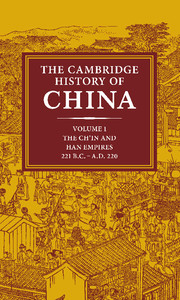Book contents
- Frontmatter
- Introduction
- 1 The state and empire of Ch'in
- 2 The Former Han dynasty
- 3 Wang Mang, the restoration of the Han dynasty, and Later Han
- 4 The conduct of government and the issues at stake A.D. 57–167
- 5 The fall of Han
- 6 Han foreign relations
- 7 The structure and practice of government
- 8 The institutions of Later Han
- 9 Ch'in and Han law
- 10 The economic and social history of Former Han
- 11 The economic and social history of Later Han
- 12 The religious and intellectual background
- 13 The concept of sovereignty
- 14 The development of the Confucian schools
- 15 Confucian, Legalist, and Taoist thought in Later Han
- 16 Philosophy and religion from Han to Sui
- Bibliography
- Glossary-Index
- Map 7 The Han empire, 143 b.c.
- Map 8 The Han empire, 108 b.c
- Map 9 The Han empire, a.d. 2
- Map 12 The Han empire, a.d. 140">
- References
11 - The economic and social history of Later Han
Published online by Cambridge University Press: 28 March 2008
- Frontmatter
- Introduction
- 1 The state and empire of Ch'in
- 2 The Former Han dynasty
- 3 Wang Mang, the restoration of the Han dynasty, and Later Han
- 4 The conduct of government and the issues at stake A.D. 57–167
- 5 The fall of Han
- 6 Han foreign relations
- 7 The structure and practice of government
- 8 The institutions of Later Han
- 9 Ch'in and Han law
- 10 The economic and social history of Former Han
- 11 The economic and social history of Later Han
- 12 The religious and intellectual background
- 13 The concept of sovereignty
- 14 The development of the Confucian schools
- 15 Confucian, Legalist, and Taoist thought in Later Han
- 16 Philosophy and religion from Han to Sui
- Bibliography
- Glossary-Index
- Map 7 The Han empire, 143 b.c.
- Map 8 The Han empire, 108 b.c
- Map 9 The Han empire, a.d. 2
- Map 12 The Han empire, a.d. 140">
- References
Summary
Social and economic history is seldom marked by distinct turning points. In the Han period, each of the four centuries witnessed major developments in the organization of the society and economy. Still, the society of the first century A.D. was very close to that of the first century B.C., with established patterns largely continued, and it is purely as a matter of convenience that the social and economic history of the dynasty is viewed here in terms of two periods rather than three or four. Because of the numerous continuities between Former and Later Han, a full description of the economic and social life of the Later Han is not necessary. Such matters as diet, housing, clothing, means of transport, the organization of families, villages, and enterprises changed only very slowly during Han, often too slowly for changes to be perceived in the kinds of sources surviving today. Moreover, the basic features of agricultural technology and financial administration have already been described in preceding chapters. In this chapter emphasis will be placed on describing and analyzing major structural changes in the economy and society, such as the reorganization of agricultural production, the emergence of new forms of local organization, and the continuing evolution of the composition of the upper class.
ECONOMIC HISTORY
From a reading of the Standard Histories one might think that a major shift in economic development occurred between the Former and the Later Han. In Later Han sources, great merchants are mentioned less frequently, and “drifting” peasants are mentioned much more frequently.
- Type
- Chapter
- Information
- The Cambridge History of China , pp. 608 - 648Publisher: Cambridge University PressPrint publication year: 1986
References
- 11
- Cited by

